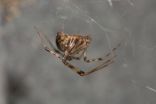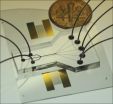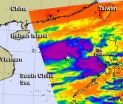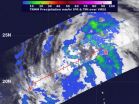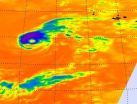(Press-News.org) MINNEAPOLIS / ST. PAUL (10/02/2012) —A team of scientists and engineers at the University of Minnesota has invented a unique microscale optical device that could greatly increase the speed of downloading information online and reduce the cost of Internet transmission.
The device uses the force generated by light to flop a mechanical switch of light on and off at a very high speed. This development could lead to advances in computation and signal processing using light instead of electrical current with higher performance and lower power consumption.
The research results were published today in the online journal Nature Communications.
"This device is similar to electromechanical relays but operates completely with light," said Mo Li, an assistant professor of electrical and computer engineering in the University of Minnesota's College of Science and Engineering.
The new study is based on a previous discovery by Li and collaborators in 2008 where they found that nanoscale light conduits can be used to generate a strong enough optical force with light to mechanically move the optical waveguide (channel of information that carries light). In the new device, the researchers found that this force of light is so strong that the mechanical property of the device can be dominated completely by the optical effect rather than its own mechanical structure. The effect is amplified to control additional colored light signals at a much higher power level.
"This is the first time that this novel optomechanical effect is used to amplify optical signals without converting them into electrical ones," Li said.
Glass optical fibers carry many communication channels using different colors of light assigned to different channels. In optical cables, these different-colored light channels do not interfere with each other. This non-interference characteristic ensures the efficiency of a single optical fiber to transmit more information over very long distances. But this advantage also harbors a disadvantage. When considering computation and signal processing, optical devices could not allow the various channels of information to control each other easily…until now.
The researchers' new device has two optical waveguides, each carrying an optical signal. Placed between the waveguides is an optical resonator in the shape of a microscale donut (like a mini-Hadron collider.) In the optical resonator, light can circulate hundreds of times gaining intensity.
Using this resonance effect, the optical signal in the first waveguide is significantly enhanced in the resonator and generates a very strong optical force on the second waveguide. The second waveguide is released from the supporting material so that it moves in oscillation, like a tuning fork, when the force is applied on it. This mechanical motion of the waveguide alters the transmission of the optical signal. Because the power of the second optical signal can be many times higher than the control signal, the device functions like a mechanical relay to amplify the input signal.
Currently, the new optical relay device operates one million times per second. Researchers expect to improve it to several billion times per second. The mechanical motion of the current device is sufficiently fast to connect radio-frequency devices directly with fiber optics for broadband communication.
Li's team at University of Minnesota includes graduate students Huan Li, Yu Chen and Semere Tadesse and former postdoctoral fellow Jong Noh. Funding support of the project came from the University of Minnesota College of Science and Engineering and the Air Force Office of Scientific Research.
INFORMATION:
To read the full research paper, visit the Nature Communications website at http://z.umn.edu/optical.
University of Minnesota engineers invent new device that could increase Internet download speeds
Unique device uses light to control light
2012-10-03
ELSE PRESS RELEASES FROM THIS DATE:
1 glue, 2 functions
2012-10-03
Akron, Ohio, Oct. 2, 2012 — While the common house spider may be creepy, it also has been inspiring researchers to find new and better ways to develop adhesives for human applications such as wound healing and industrial-strength tape. Think about an adhesive suture strong enough to heal a fractured shoulder and that same adhesive designed with a light tackiness ideal for "ouch-free" bandages.
University of Akron polymer scientists and biologists have discovered that this house spider — in order to more efficiently capture different types of prey — performs an uncommon ...
Too little nitrogen may restrain plants' carbon storage capability, U of M paper shows
2012-10-03
MINNEAPOLIS / ST. PAUL (10/02/2012) —Plants' ability to absorb increased levels of carbon dioxide in the air may have been overestimated, a new University of Minnesota study shows.
The study, published this week in the journal Nature Climate Change, shows that even though plants absorb large amounts of carbon dioxide and actually can benefit from higher levels of it, they may not get enough of the nutrients they need from typical soils to absorb as much CO2 as scientists had previously estimated. Carbon dioxide absorption is an important factor in mitigating fossil-fuel ...
Acoustic cell-sorting chip may lead to cell phone-sized medical labs
2012-10-03
UNIVERSITY PARK, Pa. -- A technique that uses acoustic waves to sort cells on a chip may create miniature medical analytic devices that could make Star Trek's tricorder seem a bit bulky in comparison, according to a team of researchers.
The device uses two beams of acoustic -- or sound -- waves to act as acoustic tweezers and sort a continuous flow of cells on a dime-sized chip, said Tony Jun Huang, associate professor of engineering science and mechanics, Penn State. By changing the frequency of the acoustic waves, researchers can easily alter the paths of the cells.
Huang ...
Payoff lacking for casino comps
2012-10-03
A study of widely used complimentary offers at Atlantic City casinos finds that common giveaways such as free rooms and dining credits are less profitable – and lead to unhealthy competition among casinos – than alternative comps such as free travel and parking.
The research, co-authored by Seul Ki Lee, an assistant professor at Temple University's School of Tourism and Hospitality Management, analyzed monthly promotional allowance and expenditure data from 11 casinos in the Atlantic City market from 2008 to 2010. Atlantic City is the second largest gaming market in ...
Study reveals differences in overall health of Latino-American subgroups
2012-10-03
TALLAHASSEE, Fla. - Despite a shared Latino heritage, there are significant differences in the overall health and the use of health-care services among Cuban-Americans, Mexican-Americans and Puerto Rican-Americans — even between men and women in the same subgroup — according to two recently published studies by Florida State University researchers.
The authors, led by College of Social Work Professor and Associate Dean Amy L. Ai, evaluated the physical and behavioral health, as well as the health care service usage, of all three major Latino subgroups in the United States. ...
Cedars-Sinai study sheds light on bone marrow stem cell therapy for pancreatic recovery
2012-10-03
LOS ANGELES (Oct. 2, 2012) – Researchers at Cedars-Sinai's Maxine Dunitz Neurosurgical Institute have found that a blood vessel-building gene boosts the ability of human bone marrow stem cells to sustain pancreatic recovery in a laboratory mouse model of insulin-dependent diabetes.
The findings, published in a PLOS ONE article of the Public Library of Science, offer new insights on mechanisms involved in regeneration of insulin-producing cells and provide new evidence that a diabetic's own bone marrow one day may be a source of treatment.
Scientists began studying ...
NASA sees strong thunderstorms in Tropical Storm Gaemi
2012-10-03
Infrared NASA satellite imagery revealed that the strongest thunderstorms within Tropical Storm Gaemi in the western North Pacific Ocean were located around the storm's center and in a band of thunderstorms east of the center.
On Oct. 2, 2012 at 1500 UTC (11 a.m. EDT) Tropical Storm Gaemi had maximum sustained winds near 40 knots (46 mph/74 kph). It was located about 515 nautical miles (592 miles/954 km) east of Hue, Vietnam, near 15.3 North latitude and 116.7 East longitude. Gaemi is moving to the southeast at 9 knots (10 mph/16.6 kph).
Infrared imagery from the AIRS ...
NASA sees heaviest rainfall in Tropical Storm Maliski's eastern side
2012-10-03
Wind shear is pushing the heaviest rainfall within Tropical Storm Maliksi east of the storm's center, and NASA's TRMM satellite captured it on Oct. 2 as it passed overhead from space.
When NASA's Tropical Rainfall Measuring Mission (TRMM) satellite passed over Tropical Storm Maliksi on Oct. 2 at 1206 UTC (8:06 a.m. EDT), the precipitation radar instrument detected light rainfall occurring over most of the storm. The heaviest rainfall was moderate was falling east of the center at a rate between .78 to 1.57 inches/20 to 40 mm per hour. There was a small area of heavy rainfall ...
Infrared NASA imagery shows Nadine still has an eye, despite being a tropical storm
2012-10-03
Forecasters know that Tropical Storm Nadine is a fighter as it continues to stay alive in the eastern Atlantic Ocean. Even satellite imagery shows Nadine's fighting spirit, because although Nadine is now a tropical storm, infrared data clearly shows that Nadine maintained an eye early on Oct. 2.
At 11 a.m. EDT on Oct. 2, Nadine remains a tropical storm and appears to be weakening. Nadine's maximum sustained winds were near 65 mph (100 kph). The center of Tropical Storm Nadine was located near latitude 34.2 north and longitude 37.5 west. Nadine is moving toward the east-southeast ...
Infertility treatments may significantly increase multiple sclerosis activity
2012-10-03
Researchers in Argentina report that women with multiple sclerosis (MS) who undergo assisted reproduction technology (ART) infertility treatment are at risk for increased disease activity. Study findings published in Annals of Neurology, a journal of the American Neurological Association and Child Neurology Society, suggest reproductive hormones contribute to regulation of immune responses in autoimmune diseases such as MS.
According to a 2006 report from the World Health Organization (WHO), MS affects 2.5 million individuals worldwide and is more common among women ...
LAST 30 PRESS RELEASES:
Making lighter work of calculating fluid and heat flow
Normalizing blood sugar can halve heart attack risk
Lowering blood sugar cuts heart attack risk in people with prediabetes
Study links genetic variants to risk of blinding eye disease in premature infants
Non-opioid ‘pain sponge’ therapy halts cartilage degeneration and relieves chronic pain
AI can pick up cultural values by mimicking how kids learn
China’s ecological redlines offer fast track to 30 x 30 global conservation goal
Invisible indoor threats: emerging household contaminants and their growing risks to human health
Adding antibody treatment to chemo boosts outcomes for children with rare cancer
Germline pathogenic variants among women without a history of breast cancer
Tanning beds triple melanoma risk, potentially causing broad DNA damage
Unique bond identified as key to viral infection speed
Indoor tanning makes youthful skin much older on a genetic level
Mouse model sheds new light on the causes and potential solutions to human GI problems linked to muscular dystrophy
The Journal of Nuclear Medicine ahead-of-print tip sheet: December 12, 2025
Smarter tools for peering into the microscopic world
Applications open for funding to conduct research in the Kinsey Institute archives
Global measure underestimates the severity of food insecurity
Child survivors of critical illness are missing out on timely follow up care
Risk-based vs annual breast cancer screening / the WISDOM randomized clinical trial
University of Toronto launches Electric Vehicle Innovation Ontario to accelerate advanced EV technologies and build Canada’s innovation advantage
Early relapse predicts poor outcomes in aggressive blood cancer
American College of Lifestyle Medicine applauds two CMS models aligned with lifestyle medicine practice and reimbursement
Clinical trial finds cannabis use not a barrier to quitting nicotine vaping
Supplemental nutrition assistance program policies and food insecurity
Switching immune cells to “night mode” could limit damage after a heart attack, study suggests
URI-based Global RIghts Project report spotlights continued troubling trends in worldwide inhumane treatment
Neutrophils are less aggressive at night, explaining why nighttime heart attacks cause less damage than daytime events
Menopausal hormone therapy may not pose breast cancer risk for women with BRCA mutations
Mobile health tool may improve quality of life for adolescent and young adult breast cancer survivors
[Press-News.org] University of Minnesota engineers invent new device that could increase Internet download speedsUnique device uses light to control light

